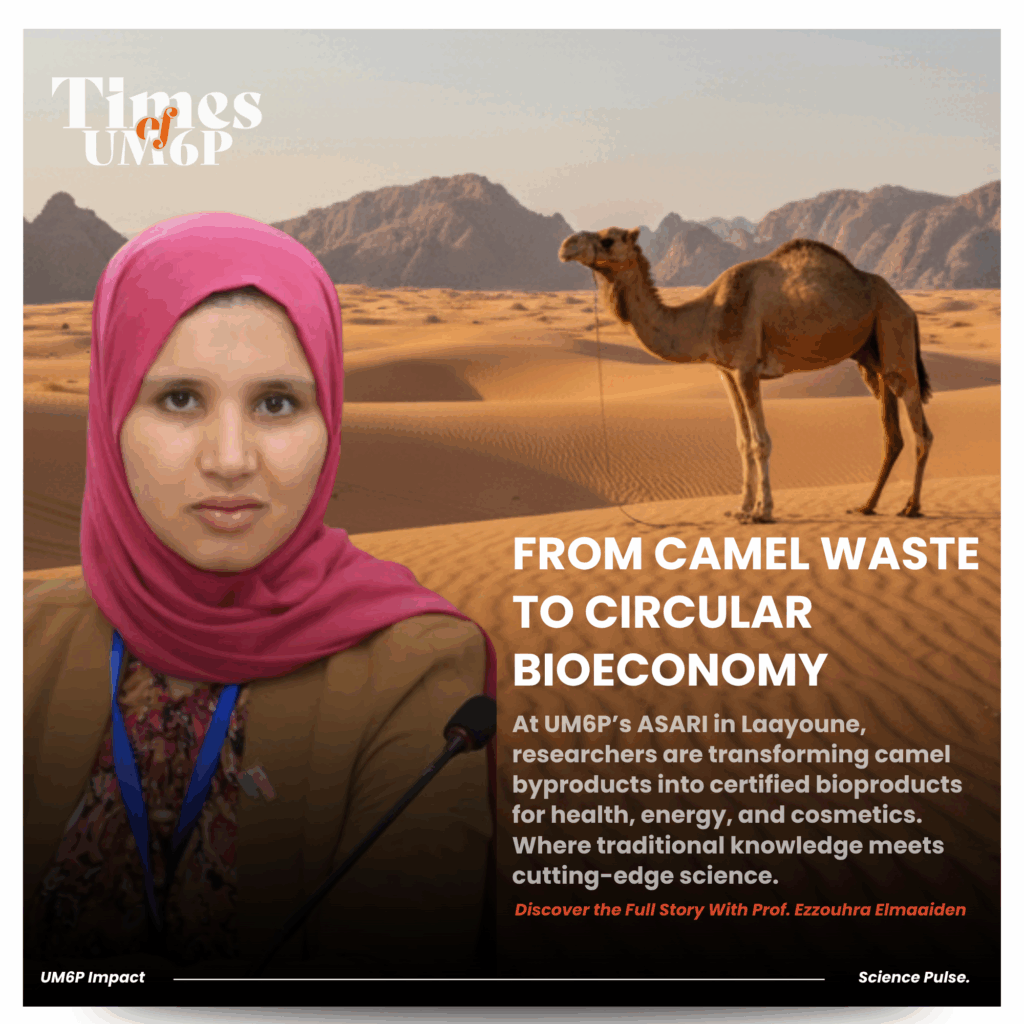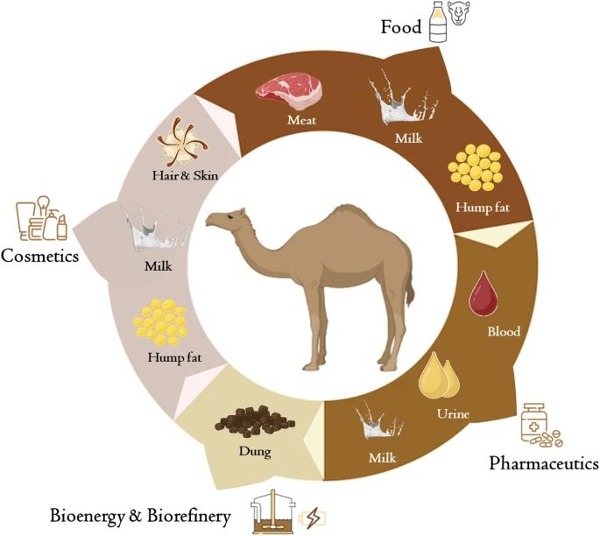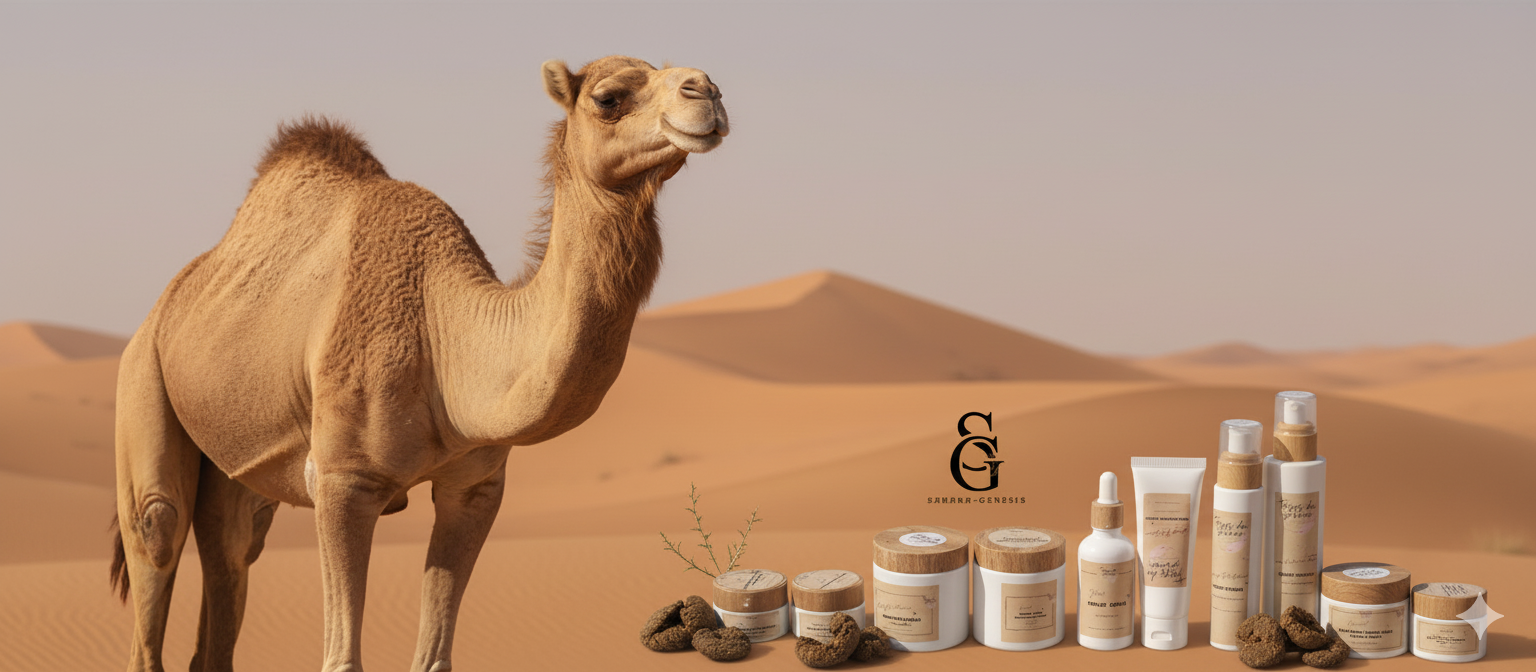How UM6P Scientists Are Building a Circular Bioeconomy from Camel Waste in Southern Morocco

How do you turn the ancient into the experimental? In the Moroccan Sahara, UM6P’s researchers are building a new kind of biolab where camel milk becomes medicine, its waste becomes energy, and nomadic wisdom meets the language of molecules. In southern Morocco, a research team at UM6P’s African Sustainable Agriculture Research Institute (ASARI) in Laayoune, is working on an unusual line of inquiry: the camel as a resource for bio-based innovation.
The project looks at what’s often left behind in camel farming – milk whey, hump fat, urine, dung – and asks what can be done with it. These are materials that are typically seen as waste. But in the right conditions, with the right process, they might offer value. They call it Camel-Du-Val. It’s supported by the Phosboucraa Foundation and led by Prof. Ezzouhra Elmaaiden, who specializes in natural product valorization.
The team includes Zineb Boubal, a PhD student focused on formulation science, and works with local cooperatives and camel breeders to explore new uses for old materials. Their approach is collaborative and process-driven, involving both fieldwork and benchwork.
Camel milk and urine have long been part of traditional medicine in the region, and camel hump fat is sometimes used in cooking or topical applications. What’s changing is how these materials are handled, processed, and evaluated.”
The project aims to expand existing practices through research, safety testing, and certification. It asks simple questions: What is in these materials? Are they stable? Are they safe? Can they be made useful beyond their current uses?
Valuable Resources, Wasted Potential
Camel farming supports livelihoods in southern Morocco, yet many of its valuable byproducts – milk whey, urine, hump fat, and dung – are often overlooked or wasted. These materials contain a wealth of active molecules and nutrients with properties ranging from antimicrobial and antioxidant to fertilizing and energy-yielding.
While traditional practices use camel urine medicinally and milk in skincare, such uses lack the validation and quality controls required for broader markets. Without certification and testing, concerns about contamination and spoilage persist, especially with fresh products.
Current efforts focus mostly on camel milk as a food, leaving other potential bioproducts underdeveloped. Supporting cooperatives with scientific validation, laboratory testing, and certification is vital to improving product safety and expanding economic opportunities for breeders.”
“Our aim is to build a sustainable camel industry that goes beyond traditional uses and supports the next generation of breeders,” says Prof. Ezzouhra Elmaaiden, project coordinator and R&D specialist in bio-based innovations. “Certification, quality control, and scientific validation are key to unlocking new markets and ensuring these products benefit local communities economically and socially.”

Functional Formulations from Camel Products
Under Prof. Elmaaiden’s scientific coordination, the Camel-Du-Val project is transforming underused camel derivatives into standardized, safe, and effective formulations. Camel milk whey is rich in lactoferrin, immunoglobulins, and proteins that support scalp health and hair strength, making it a promising ingredient for shampoos and conditioners.
Meanwhile, camel hump fat, abundant in unsaturated fatty acids, is repurposed as a lipid base in creams and balms that nourish dry and sensitive skin.
Camel urine, historically used medicinally, is examined with scientific caution. “Our role as scientists is not to endorse or reject these practices,” Prof. Elmaaiden explains, “but to rigorously validate or invalidate the safety and efficacy of camel urine through modern toxicological and phytochemical studies. We focus on isolating safe, bioactive fractions with potential antimicrobial, antifungal, anticancer, and anti-inflammatory properties, ensuring any applications are based on solid scientific evidence rather than tradition alone.”
Camel dung, often dismissed as waste, is investigated as a source of organic fertilizer, biogas feedstock, and biochar precursor. Its microbial and fibrous content make it valuable for soil restoration, renewable energy, and even bio-construction in harsh environments.
“Camel dung is not waste, it’s a bioresource,” says PhD student Zineb Boubal. “Its microbiota and fibrous content make it ideal for composting, bioconversion, and even bio-construction materials in extreme environments.”
The project emphasizes working closely with local cooperatives to ground innovations in real community needs and to empower local actors through technology transfer.
Circular Bioproduct Pipelines
Out of these efforts comes Sahara-Genesis, a skin and hair care line under development. It uses ingredients like camel milk, hump fat, and residual plant oils. Products include shampoos, lip balms, and creams.
The project is also producing anti-inflammatory formulations and exploring bioactive compounds for further testing. These are early-stage prototypes, but they already show that desert-sourced materials can be designed into consumer products
The research team has compiled a database on camel-derived biomolecules, mapping how things like diet or lactation affect their chemical profiles. They’re also comparing camel data to that of other livestock.
These findings support ongoing formulation work but also give local breeders and cooperatives more insight into the animals they work with. The team hopes this knowledge will help improve husbandry, storage, and processing decisions over time.”
Importantly, the project isn’t operating in a vacuum. It runs workshops, hosts WhatsApp groups, and travels in mobile caravans to share knowledge with rural communities. These outreach efforts are as important as the lab work.
Researchers collect feedback, observe local practices, and adapt their approaches accordingly. The idea is to keep things practical and relevant. They’re engaging with the people who live with these animals every day.

Southern Morocco as Living Lab
Beyond the camel’s habitat, Southern Morocco is a living laboratory where local needs and scientific innovation intersect. The project collaborates with breeders, women-led cooperatives, farmers, and agricultural advisors to co-create solutions tailored to the region’s challenges.
“We’re co-creating with local communities from sampling to product testing to capacity-building. This is research for the region, with the region,” – Prof. Elmaaiden.
Through field caravans, WhatsApp knowledge networks, and on-site workshops, Camel-Du-Val functions both as a scientific platform and social innovation engine, equipping communities with tools, data, and products adapted to their environments.
It also aligns with Morocco’s Green Generation 2020–2030 strategy, which emphasizes sustainable rural development. But it’s grounded in more immediate goals: to reduce waste, add value to camel-based economies, and support small producers with tools they can use. It’s a bottom-up process that values practical solutions.
What Comes Next?
Guided by Prof. Elmaaiden, the team is transitioning from laboratory research toward market-ready products. Upcoming milestones include completing formulation dossiers and clinical validation for dermocosmetic prototypes such as moisturizers, anti-aging creams, shampoos, after-shampoo treatments, and lip balms.
Registration and certification for purified biomolecules derived from camel urine and milk, showing therapeutic potential, are underway. On the environmental side, the team is developing soil biostimulants and bioenergy solutions – composting, anaerobic digestion, and pyrolysis-based fuels – using camel dung.
Work on regulatory documents and intellectual property protection accompanies these efforts. These steps take time, and the team is deliberate in how they proceed. Each stage builds on previous findings.
“This isn’t just about launching a few products,” Prof. Elmaaiden emphasizes. “It’s about building a camel-centered innovation ecosystem that transforms desert bioproducts into sustainable economic drivers.”
In a global search for natural, resilient, and regionally adapted solutions, camel bioproducts offer a grounded paradigm where scientific validation and cultural heritage converge.
Want to dive more ?

Leave a Reply